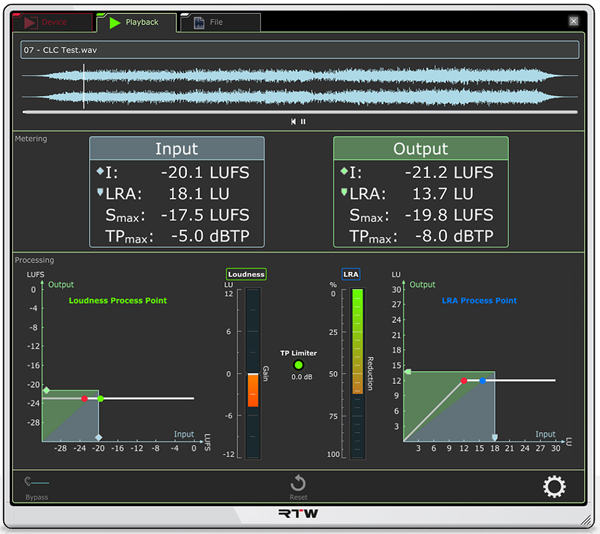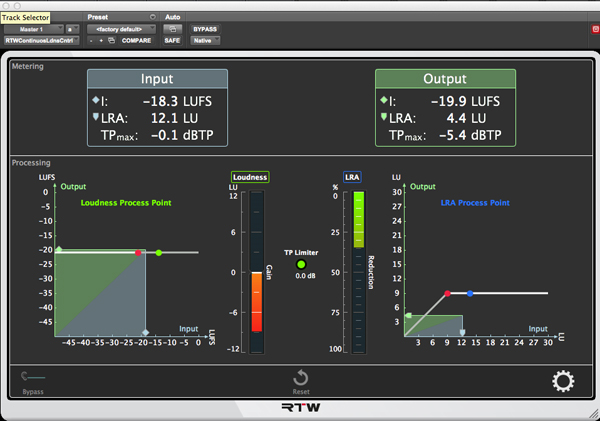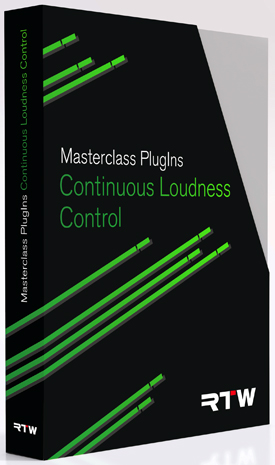|
|
RTW Continuous Loudness Control
|
|
|
 |
| RTW Continuous Loudness Control--Standalone Version |
 |
| RTW Continuous Loudness Control--Plug-In Version |
 |
| RTW Continuous Loudness Control |
RTW's Continuous Loudness Control (CLC) software comes in both standalone and plug-in versions for VST2/3, RTAS, AAX Native, and AU hosts on either Mac or PC computers. With CLC running, you can adjust the loudness level of mono to 5.1-channel program audio against a selectable program-loudness standard such as EBU R128, ITU BS.1771, ATSC A/85, ARIB, AGCOM, CALM Act, and OP-59.
CLC is not a broadband or a multi-band system dynamics processor with the typical threshold, ratio, attack and release time parameters. The patented Adaptive Morphing Technology continuously synchronizes its time and frequency response with the signal itself and offers minimal pumping, breathing, and other unwanted sonic artifacts when setting a target loudness range.
Rather than sets of specific parameters grouped as presets, while set to a worldwide loudness standard such as EBU R128, CLC offers numerous operation modes separated into categories describing the intrinsic nature of the program. There are helpful pop-up dialogs to define what each Operation mode preset and category is designed to do and whether target value attainment might be affected.
The "Art music" category would have sub categories with descriptions like Art Music 1 for "signals sensitive to artifacts; pleasant target value attainment". Operation modes vary from Pop music to dialog to sporting event audio to feature length movie sound tracks.
CLC was developed and patented by Institut für Rundfunktechnik (IRT) in Germany and uses a "look ahead low latency" algorithm to allow loudness correction to a specific target without changing the original Loudness Range. It has an adjustable True Peak limiter and improved audio metering and monitoring facilities and has been implemented into RTW's broadcast equipment to support the industry's standards for loudness control.
Both the plug-in and standalone installed at the same time--I first tried the plug-in version in Pro Tools 12 HDX on the stereo bus. The main GUI has metering that shows in real-time the Input and Output (the before and after) of loudness levels measured in LUFS (Loudness Units relative to Full Scale), the Loudness Range (LRA) which is a measure of the variation of loudness, and instantaneous true peak level.
There are also separate graphical representations of both the input signal and processed output signal that shows: the Loudness Processing point including the process head curve and moving loudness process point. The Loudness Gain bar graph shows in LU (Loudness Units) the value of either increased gain to make the LRA or the decrease caused by the True Peak limiter to maintain the LRA. There is also a percentage graph showing the reduction of LRA and a LED to indicate the action of the True Peak limiter. The plug-in finishes with a Bypass button, Reset that clears history and the Gear icon for accessing the parameter settings.
With the DAW plug-in, once satisfied with the process amount and sound, I would just "bounce to disk" or print to a new track in Pro Tools. I found using this software on top of my mix, I could see and then adjust certain internal mix elements (separate tracks) that were causing problems thereby keep the overall music level up and within spec.
The standalone version CLC has the same GUI except that I could open interleaved stereo (or multi-channel surround) audio files directly into a window in the GUI. The Playback button lets me play the file directly and, after processing, read the Input and Output (the before and after) loudness levels measured in LUFS (Loudness Units relative to Full Scale).
I used the EBU R128 Loudness Standard and ran the preset "Popular Music Programme 1" Operation Mode. I liked the way the metering works to indicate exactly what is happening. Once you have processes a file, you can compare the original file with the loudness corrected file. The last step would be to designate where the processed file is stored. Coming soon to the standalone will be Batch processing and would make an handsome addition indeed to this great and modern software product.
RTW's Continuous Loudness Control software includes both the plug-in and standalone versions and sells for $899 MSRP. For more information, check: www.rtw.com/en/products/software/clc.html.
|
|
|